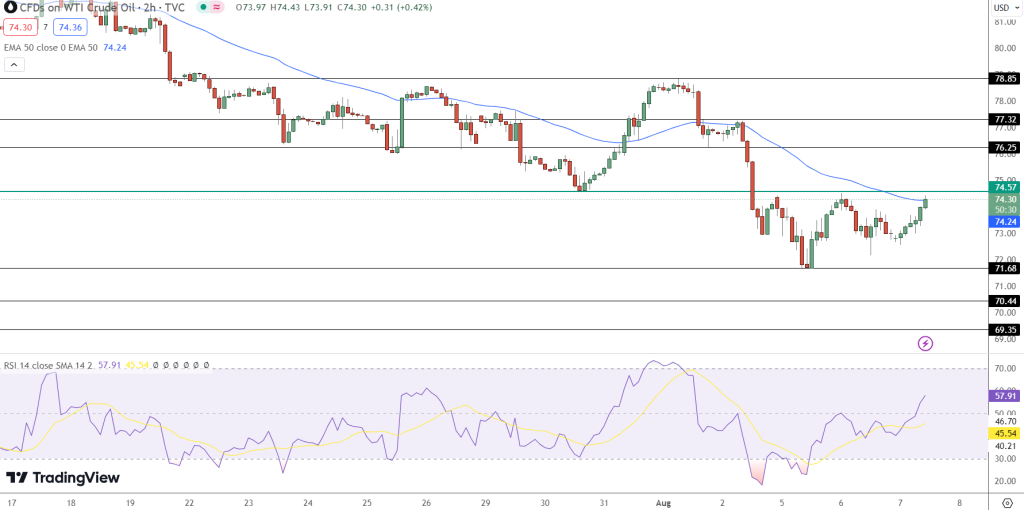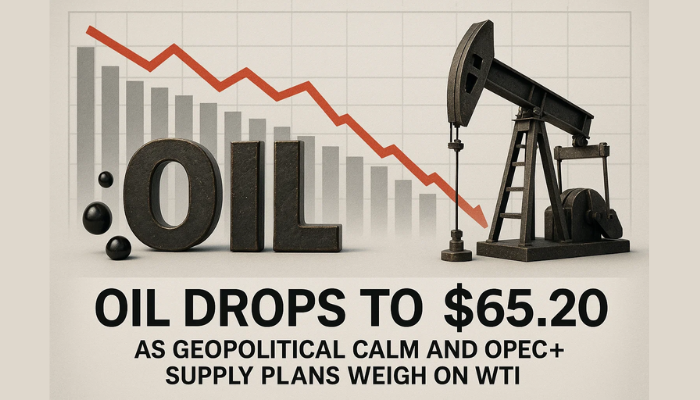WTI Crude Oil Nears $74 Amid Middle East Tensions, US Recession Fears
On Wednesday, oil prices experienced a modest increase, though Brent crude remained close to its lowest point in seven months,

On Wednesday, oil prices experienced a modest increase, though Brent crude remained close to its lowest point in seven months, under the shadow of potential U.S. recession fears and diminished demand expectations.

The recent dip in oil prices to early January levels for Brent and February lows for WTI was exacerbated by a global stock market downturn triggered by alarming U.S. employment data.
EIA expects Brent spot price to increase from $83 in August to $89 in February 2025
and to average $85.53 from August 2024 through December 2025#energy #OOTT #oilandgas #WTI #CrudeOil #fintwit #OPEC #Commodities #commoditiesmarket pic.twitter.com/FA13KvYGNR— Art Berman (@aeberman12) August 6, 2024
Geopolitical Influences and Inventory Surprises
Oil markets found some support as tensions in the Middle East heightened concerns about potential disruptions in oil production.
The situation has been particularly tense following last week’s significant escalations, which included the killing of key figures from Hamas and Hezbollah.
Daniel Hynes, an analyst at ANZ, commented, “Any escalation in Middle East conflicts could significantly disrupt oil supply, heightening global supply concerns.”
Moreover, unexpected increases in U.S. crude oil and gasoline inventories, as reported by the American Petroleum Institute, initially pushed prices lower earlier in the week, indicating a potential oversupply.
Economic Data and Market Sentiment
The bearish sentiment was further bolstered by Chinese trade data revealing a drop in daily crude oil imports to their lowest since September 2022, signalling a cooling demand in one of the world’s largest oil consumers.
As market analysts and investors digest these developments, Tamas Varga from oil brokerage PVM noted, “It remains to be seen whether this recent stabilization in oil prices is a pause in a larger selloff or a recalibration based on U.S. employment data.”
U.S. Energy Information Administration (EIA) was also set to release its weekly inventory data, which could provide further direction to the market. The interplay of reduced demand prospects, geopolitical risk, and fluctuating inventory levels continues to create a complex landscape for oil prices.
As Secretary of State Antony Blinken remarked, maintaining stability in the Middle East is crucial, emphasizing ongoing discussions with regional partners to avoid further escalations.
WTI Crude Oil Price Prediction
The price of WTI Crude Oil has shown signs of a bullish recovery in recent sessions. As of now, the commodity is trading at approximately $74.30, with a mild gain of +0.42%.
The 2-hour chart reveals that the price is hovering just below the immediate resistance level at $74.36. Key support levels are set at $74.24 and further down at $73.00, providing potential stabilization points if a pullback occurs.

The Relative Strength Index (RSI) is currently at 57.91, reflecting neither overbought nor oversold conditions, indicating that there might be room for further price movement before any significant reversal is likely.
Additionally, the price has recently crossed above the 50-day Exponential Moving Average (EMA), which is set at $74.24, suggesting that bullish momentum could be sustained in the near term.
Conclusion:
The technical indicators support a bullish outlook for WTI Crude Oil above the $74.50 mark.
- Check out our free forex signals
- Follow the top economic events on FX Leaders economic calendar
- Trade better, discover more Forex Trading Strategies
- Open a FREE Trading Account


